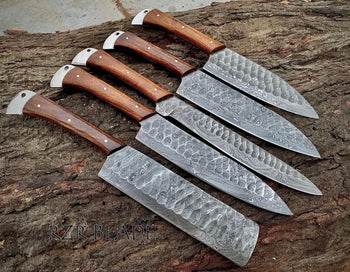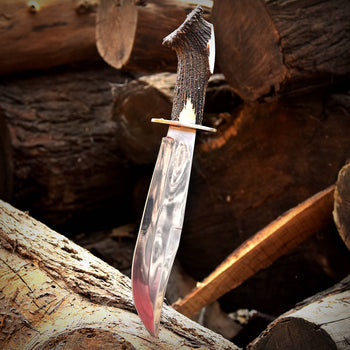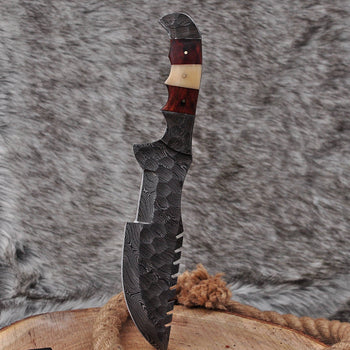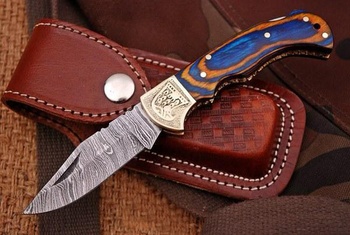A sharp knife is essential for safety, precision, and efficiency in the kitchen, outdoors, or for any cutting task. A dull blade requires more force to cut, increasing the risk of slipping and injury. Regular sharpening keeps your knives in top shape, ensuring they perform optimally. In this guide, we'll explore different sharpening methods, tools, and best practices to help you maintain razor-sharp knives.
Understanding Knife Sharpening
Knife sharpening is the process of grinding and refining the blade to restore its sharp edge. This involves removing a small amount of metal to create a fine, sharp bevel. There are various methods to achieve this, depending on the tools available and the type of knife you are sharpening.
Tools for Sharpening Knives
There are several tools you can use to sharpen your knives effectively:
Whetstones (Sharpening Stones): Available in different grits, these stones offer precise sharpening and are ideal for maintaining high-quality hunting knives.
Honing Rods (Sharpening Steels): These are used to realign the blade’s edge and maintain sharpness between full sharpenings.
Electric Knife Sharpeners: Convenient and quick, these machines automatically grind and sharpen blades at the correct angle.
Manual Knife Sharpeners: Compact and easy to use, these sharpeners use fixed-angle slots with abrasive materials to restore the edge.
Sharpening Systems: These guided systems provide controlled sharpening angles for consistency and precision.
Step-by-Step Guide to Sharpening Knives
Sharpening with a Whetstone
A whetstone is one of the most effective ways to sharpen a knife. Follow these steps:
Step 1: Soak the Stone
If using a water stone, soak it in water for 10–15 minutes before sharpening. Oil stones do not require soaking but need a thin layer of oil.
Step 2: Position the Knife
Place the stone on a stable surface. Hold the knife at a 15–20-degree angle against the stone.
Step 3: Sharpen the Blade
Using moderate pressure, slide the knife across the stone in a sweeping motion, covering the entire blade length. Repeat this process 10–15 times on one side, then switch to the other side.
Step 4: Use a Finer Grit
If your stone has multiple grits, start with the coarse side to reshape the edge and finish with the fine side for a polished, razor-sharp finish.
Step 5: Clean the Blade
Rinse and wipe the knife clean before use.
Using a Honing Rod
A honing rod helps maintain sharpness between sharpening sessions.
Hold the rod vertically with the tip resting on a surface.
Position the knife at a 15–20-degree angle and draw the blade down the rod in a sweeping motion.
Repeat on the other side for about 5–10 strokes.
Using an Electric Knife Sharpener
Insert the blade into the designated slot.
Slowly pull the knife through the sharpening mechanism.
Repeat the process as instructed by the manufacturer.
Wipe the blade clean after sharpening.
Using a Manual Knife Sharpener
Place the sharpener on a stable surface.
Insert the knife into the slot and pull it through with moderate pressure.
Repeat the process a few times until the edge is restored.
Tips for Maintaining Sharp Knives
Hone regularly: Use a honing rod frequently to keep the edge aligned.
Store properly: Use a knife block, magnetic strip, or protective sheath to prevent dulling.
Use the right cutting surface: Wooden or plastic cutting boards are best for maintaining sharpness.
Hand wash your knives: Avoid dishwashers, as harsh detergents and high heat can damage the blade.
Conclusion
Sharpening your knives regularly not only improves performance but also enhances safety. Whether using a whetstone, honing rod, electric sharpener, or manual sharpener, the key is to maintain the correct angle and apply consistent pressure. With proper care and regular sharpening, your damascus steel axe or knife will stay sharp and last for years to come. Happy sharpening!






![Alice Belts Are Back [Ultimate Guide] – Classic Military Gear for Today’s Adventurer](http://aj-sanity.com/cdn/shop/articles/DSC_6190.webp?v=1749141273&width=100)
![Top 5 Father’s Day Gifts for Dads Who Love Adventure [2025]](http://aj-sanity.com/cdn/shop/articles/DSC_2420_1fdbad4a-e3b1-42e3-bb1b-b78100cd538b.webp?v=1748364808&width=100)

